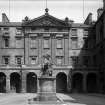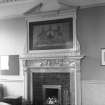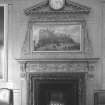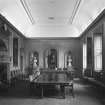Pricing Change
New pricing for orders of material from this site will come into place shortly. Charges for supply of digital images, digitisation on demand, prints and licensing will be altered.
Publication Account
Date 1951
Event ID 1097645
Category Descriptive Accounts
Type Publication Account
Permalink http://canmore.org.uk/event/1097645
23. The City Chambers, Royal Exchange, 249 High Street.
In 1680 Thomas Robertson, bailie and ex-Treasurer of the burgh,* built at his own expense an Exchange for the use of Edinburgh merchants. It was placed at the S.E. corner of the Parliament Close, and the plans were prepared by Sir William Bruce of Balcaskie, the architect of the Palace of Holyroodhouse.** Robertson's building was, however, destroyed by fire in 1700, and its successor was not favoured by the merchants, who preferred to transact their business in the open beside the Mercat Cross (1). In 1750 the pavement round the statue of Charles II in the Parliament Close was assigned as their meeting place (2); but it was felt in influential circles that the City ought to have an Exchange appropriate to the dignity of a capital. A full account of the scheme then mooted will be found in The Book of the Old Edinburgh Club (3), from which it appears that the first action of the Commissioners appointed to carry out this and other civic improvements was to obtain powers for the purchase of a site in the neighbourhood of the Cross. It so happened that on the N. side of the High Street, immediately opposite the Cross, there were a number of semi-ruinous buildings, mostly of stone but some of wood, grouped round Mary King's Close, Stewart's Close, and Allan's Close; these covered in all an area with a frontage of 150 ft., the depth extending from the High Street to the North Loch. The various properties were purchased and with one exception (infra) were demolished, the debris going to make up the Castle Esplanade. Then in 1753 competitive plans and estimates for the new Exchange were taken from John and Robert Adam, architects, and from “the Gentlemen of Mary's Chapel”, the latter a company comprising a mason and three wrights directed by John Fergus, an architect. While the plan of the brothers Adam was adopted, its execution was entrusted to "the Gentlemen," under the supervision of the Deacons of the Crafts. The foundation stone of the new building was laid on 13th September of the same year.
The contract specified that the plan of the building was to take the form of a hollow square, that is to say on the N. side there was to be a main block with a wing running S. from either end to meet a low range facing the street and completing the enclosure. Through the centre of this range was to run the entry to the courtyard. The courtyard, which was to measure 83 ft. from N. to S. by 89 ft. from E. to W., was to open into a piazza, 13 ft. deep, within the main block on its N. side. The lay-out specified is not characteristic of the Adam family but bears a close resemblance to that of Holyroodhouse, and it is therefore tempting to suppose that Bruce's design for the first Exchange was copied to some extent for this one. The piazza here was to be appropriated by the merchants as a place of exchange, while the remainder of the accommodation was to include a custom-house; thirty-five shops, fourteen of which were to have rooms above them; ten dwelling-houses, four of them below the level of the courtyard; two printing houses; and three coffee-houses-altogether a curious assortment, the reason for which is seen in the financial summary given below. The courtyard, however, was not completed as originally proposed, for an existing building used by the Writers to His Majesty's Signet was incorporated on the W. side. The plan carried out is reproduced by R. Miller in The Municipal Buildings of Edinburgh, Plate vi.
The manner in which the scheme was financed is of interest. At the outset a number of citizens, whose names are recorded on a list preserved in the National Museum (4) agreed to subscribe £445 8s. od. towards the cost of the work, and others followed their example. Then the magistrates raised loans amounting to £10,000 free of interest from the Bank of Scotland and the Royal Bank. With these sums in hand they had to face the cost of the site, about £10,000 in all, and of the new building which was estimated at £15,128 16s. 2d. They agreed to advance £18,000 at 4% to the contractors, who were to put up the building, sell the properties as these were completed, and hand over the proceeds to the Town together with any balance outstanding. The magistrates proposed to place 40% of the proceeds to the site account; and further planned to keep the Custom-house in their own hands, letting it to the Government at an annual rent of £360, as well as one of the shops, which was to be used as an office by the Burgh Chamberlain. As things turned out, the magistrates were unable to implement their bargain with the contractors, who had to seek advances elsewhere at a higher rate of interest. Indeed, throughout the contract "the Gentlemen" were hard put to it to find the necessary finance; but they managed to carry the project through with some assistance, and in 1766 they received a full discharge from their obligations on four of their number executing bonds for the balance of £2,006 due to the Town. In the end many of the properties had to be sold for a lower figure than had been proposed. And when all the work was done the merchants failed to frequent the new place of Exchange, preferring their customary stances (5).
In 1811 the Town decided to centralise the various departments of the Corporation by installing them in the Royal Exchange. The re-acquisition of the various properties therein proved a slow process, but eventually the whole building came into the hands of the Town. In 1871 the main block on the N. side of the courtyard was remodelled internally. Twenty-five years later the whole building was altered and extended. The vast increase that has taken place in municipal business since the war of 1914-18 made further extension imperative in 1930, and to-day the municipal offices extend E. over the sites of Allan's and Craig's Closes and W. over those of Writer's Court and Warriston's Close. But despite such extensive alteration the elements of the original building are still clearly recognisable, and they will be found to follow the conditions of contract closely. It is obvious that "the Gentlemen" took pride in their work and gave of their best.
As the building stands to-day the main block on the N., the whole of the E. wing and the S. end of the W. wing are in the main original, although they have all been remodelled internally to some extent. Towards the High Street the elevation is four main storeys in height, but from Cockburn Street on the N. the building rises in an impressive cliff 120 ft. high and contains twelve storeys in all, including entresol floors. As it stood until 1896, when it was remodelled, this N. elevation was bald, if not mean, in appearance; but it must be remembered that when it was built no-one's amenity or prospect was affected as the New Town had not yet been envisaged. The masonry is of Craigleith stone throughout. The lower part of the front is of polished ashlar, channel-jointed in certain parts, while the superstructure is scabbled, with polished and moulded dressings for relief. The sides and back were of rubble, but in the alterations a certain amount of ashlar has been used. As for the front elevation, the pavilion ends of the wings are united by an arcade of seven arches, flat-roofed and surmounted by a balustrade with urns as finials. This arcade is modern, and replaces the original one which had a central access to the courtyard with archways containing shops on each side. The main block on the N. of the courtyard is advanced at the centre. The piazza at its base lies within a channel jointed arcade of seven arches surmounted by a balustrade. Within the balustrade the central part of the facade is pilastered and surmounted by an entablature with a raking pediment which contains the arms of the burgh in the tympanum. The first floor windows have moulded architraves, in some cases rusticated, and the lintels have key-stones. Their friezes are cushioned and the cornices are moulded. The second-floor windows have neither rustication nor keystones, and from those of the third floor friezes and cornices are also omitted. Apart from the absence of pilasters and entablature the sides of the wings facing the courtyard are generally similar in treatment to the facade of the main block, but the arcades at their base, where originally there were shops, have now been filled in. The N. end of the W. side is quite modern, replacing as it does the building retained when the site was cleared (supra). See Fig. 246 [SC 1161573].
In the original arrangement of the main block there were two coffee-houses on the ground floor, situated one on either side of a central entry within the piazza. This entry led N. to the great staircase, which is housed within a central projection from the back of the building. The staircase is intact and is one of the most interesting features in the whole building. The fine scale-and-platt stair started at the courtyard level but to-day continues downwards. The steps are of stone and the landings are arched in an ingenious manner; the balustrade is of oak with turned balusters and a nicely moulded rail with "easings" at the newel posts. Of the rooms to which it leads the old Council Room on the first floor, now No. 2 Committee-Room, is undoubtedly the finest. Once this had been completed it became the meeting place of the Convention of Royal Burghs, and here likewise the Town Council met from 1811 until 1903. Successive coats of paint and varnish obscured its fine detail until a few years ago, when a fire occurred and the Council thereupon had the room fittingly restored by the City Architect. As the room now stands, the entrance from the staircase leads into an ante-room which opens through an arcade on the E. into the committee-room. Both divisions are treated in a uniform manner, with Memel pine panelling, an enriched cornice and a coved ceiling. The committee room has three windows to the courtyard while the ante-room has only one. There are two doorways in each division with finely carved friezes and broken pediments. The mantelpiece in the N. wall of the committee-room matches these but its carving is even more elaborate. Inset in the overmantel is a painting of Edinburgh Castle dated 1886. Three niches have been formed in the E. wall to hold pieces of sculpture. Those at the side contain busts of no special interest, but the one in the centre contains a bronze statue in Roman military costume commonly held to represent “Bonnie Prince Charlie”, but more probably Florentine work of the 16th or 17th century.*** Several of the other rooms, such as the S.E. room on the first floor of the W. wing, still retain their contemporary mantelpieces, while in others-for example the Lord Provost's room at the diametrically opposite corner of the building-the mantelpieces were renewed at the turn of the 18th and 19th centuries. But most of the rooms have been modernised and are not of outstanding interest.
RCAHMS 1951
(1) R. Miller, The Municipal Buildings of Edinburgh, p. 111. (2) Minute of Town Council, 17th October 1750. (3) xxii, p. 1. (4) P.S.A.S., iv (1860-2), pp. 554, 593-7. (5) Pennant, A Tour in Scotland, i, p. 52.
*For his tombstone see p. 70.
**Robertson received in return several ‘obligements’ at the hands of the Town Council.
***The story goes that the statue was cast in France and shipped in a case from Dunkirk to Leith where, in course of being unloaded, it fell into the harbour and lay submerged for many years. Ultimately raised, the chest and its contents lay undisturbed for some thirty years in the Leith Weigh-house, and were then transferred to St. Giles Church. Not until 1810, according to the Scots Magazine, lxxii (1810), p . 797, had anyone sufficient curiosity to open the chest and find the statue, which finally came to rest in the City Chambers. Cf. Grant, Old and New Edinburgh, i, pp. 184-6.













